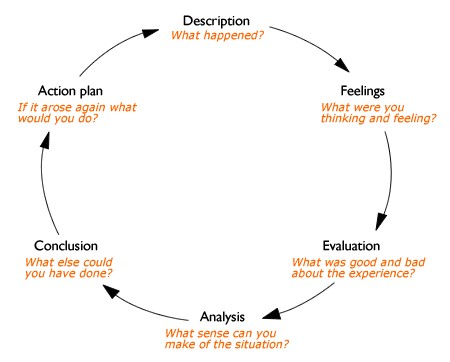
Be more reflective
Trust me – it’s time to reflect on successes and failures using a reflective cycle of questioning.
If you are anything like me, you are always harsh on yourself, have times of self-doubt and often suffer from ‘imposter syndrome’ – and let’s be honest, these feelings and thoughts are hardly ever productive.
Therefore, if you are feeling a bit down or negative about your business and your content output, I highly recommend putting these emotions to good use and being ‘productively critical’ and ‘self-reflective’.
I think these are skills that not enough of us study or learn to do effectively. Therefore, I want to share my knowledge and give you an easy guide to reflecting specifically on your content, but perhaps you can expand upon this to apply it to your business more widely. At the end of the day, there is no point constantly putting out the same content or trying things ad hoc, without considering what is working and not working
Reflective Cycle
When I was commissioning editor at Palgrave Macmillan, I worked on a lot of textbooks for nursing, midwifery and social work. As students, one of their main tasks, particularly on placement and when doing research, is to do reflective writing. The starting point in most textbooks on how to do this is Gibbs’ Reflective Cycle (1988) (see image below).

The Reflective Cycle (Gibbs, 1988)
The idea is that you think systematically about an experience or activity, asking yourself questions and importantly considering ‘what would you do next time’.
Let me show you how I have applied this to a situation I had recently:
Description: On a bit of a whim, a friend and I created an ‘introductory’ video for an upcoming workshop we were running. Simply giving our names, time and location of the workshop and a brief outline.
Feelings: I worried it was a bit of a waste of time. The workshop was only a week away and the video was done in 5 minutes, more as an experiment
Evaluation: In the moment, it was actually quite fun, as well as nerve-racking, posting the video to Facebook. Four days later, it was the best content creation decision I have recently made – it reached over 1000 people (nearly 10 times more than my usual posts) and secured not only more people for the workshop, but also people enquiring about future dates. This sort of reach on Facebook currently is so difficult to get, and hence, so valuable.
Analysis: From this, I have to conclude that video is worth doing more often. It doesn’t have to be polished, and can be very casual, even completely live. The film itself doesn’t have to be long, but needs to have a clear message.
Conclusion: Whilst the video certainly had a good reaction, I wonder if a little more planning of what to say may have helped (for example, we forgot to say the city in which the workshop took place!).
Action Plan: For any event, offer or announcement I have planned, I will certainly do a short video to promote it. I will ensure this is done far enough in advance to get the desired reaction and reach. Then, when I do next my video I can used this cycle again to see what outcomes I achieved and compare.
I admit this is a positive story, but I hope it shows how answering the simple questions in the model can offer useful critical analysis and a plan for future. It also only took me about 10 minutes to write it all out.
Pick out 3 content items which ‘failed’
‘Failed’ will be subjective, depending on your ‘norm’ and your goals. For a big international company, a Facebook post which only reaches 5000 people might be a fail, whereas for myself, a post which reaches less than 50 people would be quite disappointing, for example. So, start by doing a quick bit of analysis and work out firstly what your average numbers are for reach on Facebook, ‘Likes’ on Instagram, blog post views or click rates on newsletters, etc.
Then, I would recommend picking just three items of content that didn’t meet your averages and doing a little critical analysis. This could be any item of content, e.g. a Facebook post (especially one you had spend a bit of time preparing); a blog post, an Instagram photo or newsletter/email campaign. Or you could pick just one method of output, i.e. Facebook posts, and compare three.
Now, go through the cycle, answer the questions and see what you can identify. Are there any patterns (i.e. time of day, style of post, inclusion/lack of certain types of media, length)?
Pick out 3 content items which ‘succeeded’
Similarly, consider items which succeeded your averages and your expectations – like the video! Ideally, pick three which are similar in style or output method to your ‘fails’.
Then, compare and contrast.
If you don’t have time for three, just do one. Being reflective, critical and analytical can become a really good and productive habit. It turns from being negative (what went wrong again?) to a positive (what can I do better next time?). However, you need to take that first step.
Let me help you
Small exercises like this can lead to big and quick wins. As part of helping you with your content strategy, this is the type of thing I can help you with too; both the initial analysis and working through a reflective cycle. From this we can also draw conclusions and set out simple rules. For example, a Facebook post works best when I do x, y and z. Blog posts reach more people when I do a, b and c, etc.
Go on, reflect away and move forwards with your content creation.
Oh…and if you want to see the video – click here!